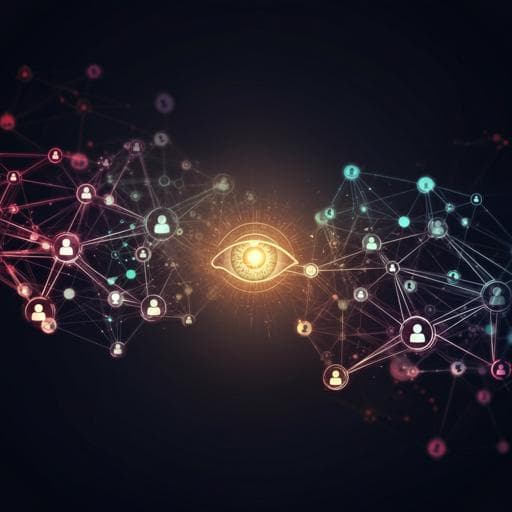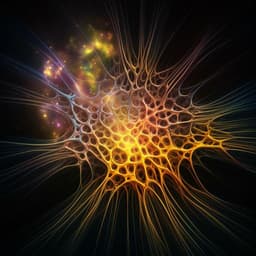
Psychology
Distinct neural mechanisms of social orienting and mentalizing revealed by independent measures of neural and eye movement typicality
M. Ramot, C. Walsh, et al.
Explore the fascinating findings of this study conducted by Michal Ramot, Catherine Walsh, Gabrielle Elise Reimann, and Alex Martin, as they delve into the distinct yet overlapping neural systems that underpin social orienting and mentalizing in both typically developing and autistic individuals. Discover how eye movement and neural typicality measures reveal the intricate workings of the 'social brain.'
~3 min • Beginner • English
Introduction
The study investigates whether social orienting (attention to socially relevant cues) and higher-order mentalizing (inferring others’ mental states) rely on distinct yet interacting neural systems within the social brain. Prior work shows that during movie viewing, eye movements reflect attentional selection influenced strongly by social cues (faces, gaze, speech, emotion, touch), whereas higher-level narrative comprehension is not strongly reflected in eye movement synchrony. In contrast, inter-subject correlations (ISCs) of neural responses index shared higher-level processing and interpretation. Individuals with autism spectrum disorder (ASD) exhibit difficulties in both social orienting and complex theory of mind, though effects may be subtle. The authors hypothesized a dissociation: eye movement typicality would index social orienting mechanisms, while neural typicality during movie viewing would capture higher-level social comprehension/mentalizing. By combining independent measures—eye movement typicality from short social movie clips outside the scanner and voxel-wise neural typicality (ISC) from a different movie during fMRI—the study aims to delineate distinct neural networks for social orienting and mentalizing and to assess group differences between typically developing (TD) and ASD participants.
Literature Review
- Visual attention in dynamic social scenes is influenced more by social cues (faces, gaze, speech) than by low-level visual saliency; faces are superior predictors of fixations relative to saliency maps. Gaze direction, emotion, touch, and body/head orientation further modulate social attention.
- Film editing directs viewer attention, producing attentional synchrony, but such synchrony can arise from transient social/visual cues rather than higher-order mentalizing; manipulating narrative comprehension via shuffling or changing context only weakly affects eye movement synchrony.
- Neural synchrony (ISC) during naturalistic stimuli extends beyond sensory cortex into association regions and relates to shared memory for events, shared narrative interpretation, and even social relationships (friendship), suggesting that ISCs index higher-level shared processing.
- In ASD, high-functioning adolescents and young adults often show deficits in complex theory of mind and subtle abnormalities in social orienting (e.g., eye movements to faces/social stimuli), especially detectable with complex or sensitive paradigms.
- Prior ISC studies comparing TD and ASD have been few, often underpowered, with mixed results. Neural correlates of social orienting have largely used simple/static stimuli (e.g., gaze-following), offering a fragmented view of a broader social orienting network.
- Movie viewing provides rich, naturalistic social stimuli with both shared and individual variability, enabling linkage between behavior (eye movements) and neural responses. Previous work has linked neural typicality to movie-related behaviors (e.g., memory) but not comprehensively to independent social orienting measures.
Methodology
Participants: 62 TD individuals (24 female) and 36 ASD males (ages 15–30). A matched subset of 36 TD males was selected to match the ASD group on gender, age, IQ, and motion. All were right-handed with normal/corrected vision. IQ > 94; matched IQ across groups (ASD mean 108.7±13.8; matched TD mean 110±13.3). Informant Social Responsiveness Scale (SRS) scores were collected for ASD participants.
Behavioral eye-tracking session (outside scanner): Participants viewed 24 short (14 s) clips from popular Hollywood movies (selected via pilot testing for highest between-subject consistency of gaze patterns) with audio. Eye movements were recorded using an EyeLink 1000 Plus (1000 Hz). Head stabilized; calibration performed before viewing. Clips presented full-screen (1920×1080) in random order with 6 s fixation cross inter-trial intervals. Preprocessing included removal of first/last 500 ms of each clip, blink/offscreen removal, despiking, and downsampling to video frame rate (29.97 fps). Eye position was computed per frame without fixation parsing.
Eye movement typicality metric: For each participant and movie, the Euclidean distance per frame between the participant’s gaze position and the mean gaze path of all other participants (leave-one-out) was computed and averaged across frames, yielding a per-movie distance. Participant-level eye movement typicality was the average distance across 24 clips (smaller distance = more typical). For ASD participants, typicality was computed relative to both ASD peers and matched TD averages; due to near-identity (r≈0.99 across participants), ASD eye movement typicality was defined relative to the TD average.
Stability analysis: The 24 clips were split (odd/even) and average typicality per half was correlated across participants. This was repeated over 10,000 random splits with permutation testing (participant label shuffling) to assess robustness. A control analysis demeaned per-participant gaze to rule out calibration biases.
fMRI movie session: Immediately after eye-tracking, participants viewed a different 9.5 min scene (The Princess Bride) with audio during fMRI. No eye tracking was performed in the scanner. MRI acquisition: GE 3T MR750, 32-channel coil; structural MPRAGE; EPI multi-echo (TR=2 s; TEs=17.5/35.3/53.1 ms; 3×3×3 mm voxels; 28 slices; 285 TRs; ASSET factor 2). Field of view did not cover entire brain (notably some motor and frontal/parietal regions missing).
fMRI preprocessing: AFNI pipeline: remove first 4 volumes; 3dDespike; slice timing correction; motion correction (3dVolreg); co-registration to anatomy; multi-echo ICA denoising (ME-ICA) to remove non-BOLD components; transform to Talairach space. Voxels with temporal SNR < 40 excluded. Some voxels also excluded for poor coverage.
Neural typicality (ISC): For each participant and voxel, compute Pearson correlation between that participant’s time course and the mean time course of all other participants (leave-one-out). For ASD, ISC was computed relative to ASD peers and to matched TD averages; due to high correlation (mean r=0.92 across voxels), ASD neural typicality was defined relative to the TD average.
Linking behavior and brain: Whole-brain voxelwise correlations across participants between eye movement typicality (distance; larger = less typical) and neural typicality (ISC; larger = more typical). Significant negative correlations identify voxels where more typical neural responses co-occur with more typical gaze patterns, indexing the “social orienting network.” Analyses were run for TD alone, ASD alone, and combined matched TD+ASD. For combined analyses, a control analysis regressed out group means before combining to ensure effects were not driven solely by group differences.
Group differences in neural typicality: Two-sample voxelwise t-test comparing ISC (neural typicality) between matched TD and ASD groups to identify regions with TD > ASD (and ASD > TD). Also computed average ISC within the social orienting network (defined from TD-only and combined masks) to test for network-level group differences.
Network overlap and connectivity: Conjunction analysis (p<0.01, cluster-size permutation corrected) to assess overlap between the social orienting network and the group-difference network (“network 2”). Functional connectivity within vs. across networks was assessed by computing, for each voxel, its average correlation to all other voxels within its network and comparing to its average correlation to voxels in the other network, for TD and ASD groups separately. Overlap of voxels with greater within- than across-network correlations was quantified across groups. Lateralization was assessed by voxel counts per hemisphere.
Statistics and corrections: Correlations tested with two-tailed t-tests unless stated. Cluster-size permutation corrections (10,000 iterations) were applied for voxelwise maps (eye–brain correlations and group differences) using thresholds p<0.05, 0.01, 0.005, 0.001, defining cluster sizes at the 95th percentile of permutation distributions. Within-vs-across network comparisons used paired two-tailed t-tests across participants on average within- vs across-network correlations. SRS correlations with network-averaged ISC were computed for ASD participants; Steiger’s test compared dependent correlations.
Key Findings
- Eye movement typicality is a stable individual trait: Across odd vs. even splits, correlations were high—TD all r=0.78 (p=1.9×10^-13); matched TD r=0.70 (p=2.8×10^-6); ASD r=0.73 (p=8.5×10^-7). Across 10,000 random splits, mean unshuffled correlations remained high (TD all r=0.73; matched TD r=0.67; ASD r=0.75) and far outside permutation distributions; results persisted after per-participant demeaning (TD all r=0.71; matched TD r=0.63; ASD r=0.80).
- TD participants exhibited more typical gaze than ASD: matched TD vs. ASD two-tailed t-test p=6.57×10^-6. Behavioral variance was larger in ASD (variance 533 vs. TD 163; F=3.42, p=6.57×10^-4). Eye movement typicality in ASD did not correlate with SRS (r=-0.14, p=0.45).
- Average gaze scan paths were highly similar between groups; ASD typicality computed vs. ASD peers vs. TD peers was near-identical (participant-level r≈0.99 across movies; per-movie r=0.93–0.995).
- Neural typicality (ISC) was widespread during movie viewing in TD, with highest values in sensory regions and broad association cortex; field-of-view limitations excluded some regions (notably parts of motor and fronto-parietal areas).
- Eye–brain coupling revealed a social orienting network: Negative correlations between eye movement typicality (distance) and neural typicality identified bilateral STS (anterior/posterior), IFG, anterior insula, ACC, PCC, MPFC, hippocampus, putamen, and caudate (TD-only analysis; cluster-corrected p<0.05). ASD-only analysis yielded similar regions. The TD-defined mask significantly predicted ASD behavior: within the TD-defined network, ASD participants’ average ISC correlated with their gaze typicality (r=-0.42, p=0.01). Combined matched TD+ASD analysis produced more extensive overlapping results; controlling for group means reduced extent but preserved core regions.
- Group differences in neural typicality (TD > ASD): Significant voxels included right TPJ and middle temporal gyrus, and bilateral posterior STS, IFG, anterior insula, ACC, PCC, putamen, and caudate (cluster-corrected). No regions showed ASD > TD. Although many individual voxels in the social orienting network did not differ, the network-average ISC was higher in TD using both TD-defined (p=3.5×10^-4) and combined-defined masks (p=8.8×10^-5).
- Two partially overlapping networks: A social orienting network (eye–brain coupling) and a second network defined by TD>ASD neural typicality (network 2). Non-overlapping regions of the social orienting network included anterior STS bilaterally, left pSTS and IFG, and much of bilateral ACC/PCC; regions specific to network 2 included right TPJ, middle temporal gyrus, and amygdala. Both networks showed greater within-network than across-network functional connectivity in TD and ASD. Overlap of voxels showing within>across connectivity across groups was high (99% for social orienting network; 94% for network 2). Lateralization: network 2 was predominantly right-hemisphere (78%), while the social orienting network was mildly left-lateralized (60%).
- Clinical relevance: In ASD, network 2 ISC (averaged) correlated with SRS (r=-0.35, p=0.037), whereas the social orienting network ISC did not (r=-0.15, p=0.38). The difference between these correlations was significant (Steiger’s z=-1.9, one-tailed p=0.028). Overlap regions were not significantly correlated with SRS (r=-0.22, p=0.21).
Discussion
The findings demonstrate a dissociation between two components of the social brain during naturalistic movie viewing. Eye movement typicality, a robust and stable measure of individual social orienting behavior, covaried with neural typicality in a distributed network including STS, IFG, insula, ACC/PCC, MPFC, hippocampus, and striatum—regions known to process social cues and guide attention. This supports the interpretation that similarity in gaze behavior reflects similarity in social orienting processes and is mirrored by similarity in neural responses in this network. Despite similar average gaze scan paths between TD and ASD groups, ASD participants exhibited reduced gaze typicality and greater behavioral variability.
Group differences in neural typicality identified a distinct network (network 2) centered on regions consistently implicated in mentalizing and theory of mind (notably right TPJ, middle temporal gyrus, ACC/PCC, IFG, amygdala). These regions showed reduced neural typicality in ASD, suggesting more idiosyncratic or less synchronized processing of higher-order social information. Importantly, the average ISC within the social orienting network was also lower in ASD at the network level, indicating sensitivity to group differences when assessed across the full network rather than at single voxels.
Connectivity analyses revealed that each network exhibits stronger within- than between-network functional coupling in both TD and ASD groups, with high cross-group consistency of the voxels exhibiting this property. This functional segregation, together with the behavioral double dissociation—eye movement typicality aligning with the social orienting network and clinical social impairment (SRS) aligning with network 2—supports the existence of two distinct but interacting neural systems: one for social orienting and another for mentalizing. Overlap regions (e.g., right IFG, MPFC, PCC, striatum) may support integration between orienting and inferential processes during complex social scenes.
Conclusion
This study provides convergent evidence for two distinct, partially overlapping neural systems underpinning social cognition during naturalistic movie viewing: a social orienting network linking gaze typicality to neural synchrony, and a mentalizing-related network showing reduced neural typicality in ASD and correlating with clinical social impairment. By combining independent behavioral (eye tracking on separate clips) and neural (ISC during fMRI) measures, the work delineates a broad, ecologically valid social orienting network beyond simplified stimuli and demonstrates differential alterations in ASD. Future research should examine the dynamic interactions between these networks, extend coverage to frontal eye fields and parietal regions not imaged here, incorporate concurrent eye tracking during fMRI to directly relate moment-to-moment gaze to neural activity, and test generalization across diverse social contexts and ASD subgroups including females and different functioning levels.
Limitations
- Incomplete brain coverage due to scanning parameters; some regions (notably frontal/supplementary eye fields, intraparietal sulcus, and motor areas) were outside the field of view or excluded for low tSNR, potentially omitting regions relevant to attention and eye-movement control.
- No eye tracking during fMRI; behavioral typicality was measured on different clips outside the scanner, which, while intended to generalize, prevents direct trial-by-trial linking of gaze and neural responses.
- Sensitivity of voxelwise group differences was limited within the social orienting network; group effects emerged more robustly at the network-average level, suggesting possible underpowering for single-voxel effects despite a relatively large sample for ASD research.
- Matched group analyses were male-only; findings may not generalize to females with ASD.
- Eye movement typicality metric (Euclidean distance to group mean scan path) does not parse fixation types or micro-dynamics and may overlook finer-grained aspects of gaze behavior.
Related Publications
Explore these studies to deepen your understanding of the subject.







